Scientists from the European Space Agency (ESA) are testing the smallest radar system ever flown into space to take a look at the inside of an asteroid.
The radar will be launched onboard the Juventas CubeSat, a nanosatellite measuring 10x20x30 cm, around the size of a breadbox, in the ESA's Hera mission during 2024. Many other institutions have used CubeSats, such as Technion-Israel Institute of Technology, who launched three such satellites in March 2021 as part of its Adelis-SAMSON project.
The target for this mission is Dimorphos, a 160 meter-long asteroid that is part of the Didymos binary asteroid system, alongside the 780 meter-long Didymos.
To prepare for the mission, the ESA is carrying out a test campaign, which is being done in the Hybrid European Radio Frequency and Antenna Test Zone, also known as the Hertz chamber, in the Netherlands-based European Space Research and Technology Centre following an upgrade.

“An essential element of anechoic test chambers like Hertz are the radio-absorbing foam spikes lining the inside walls, allowing tests to mimic the infinite void of space,” explained ESA antenna engineer Paul Moseley in a statement.
“But typically Hertz can only test down to 400 MHz, while Juventas’s main antennas will radiate at 60 MHz. At this frequency the spikes no longer absorb signals, so instead of a dark room the chamber would be turned into a hall of mirrors, throwing out multiple radio reflections that interfere with the accuracy of our measurements.”
The mission, which will see the probe look around 100 meters inside the asteroid, is currently slated for 2024, and will also include another CubeSat to study the composition of the asteroid's surface.
Asteroid exploration is a major field in astronomy, and many space agencies have expressed interest in exploring the many large objects in the solar system.
Three nations have landed on asteroids in the past, and many see them as possible sources for future mining operations, as these asteroids can be rich in raw materials.
While the Hera mission is currently slated for 2024, NASA is beating ESA to the punch with its upcoming Double Asteroid Redirection Test (DART) Mission. Set to be launched in November 2021, the mission will see a spacecraft launched at the Didymos system to test the possibility of asteroid deflection.
In layman's terms, it means punching an asteroid with a rocket with enough speed to change its direction by a fraction of a percent.
The ESA is watching the DART Mission with interest, and the Hera mission will be able to take an up-close look at DART's collision.
“It has taken a lot of hard work to reach the point of launching this first planetary defense mission – we’re wishing our US counterparts a great and well-deserved success,” said Ian Carnelli, overseeing ESA’s Hera mission.
“DART and Hera were originally conceived on a coordinated double-spacecraft basis, with one mission to perform the deflection and the other to perform precision measurements of the result.”
